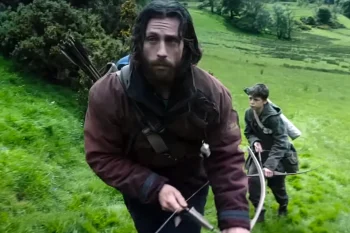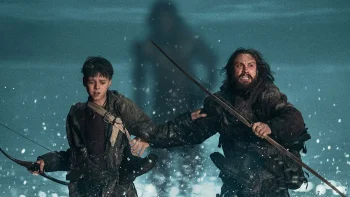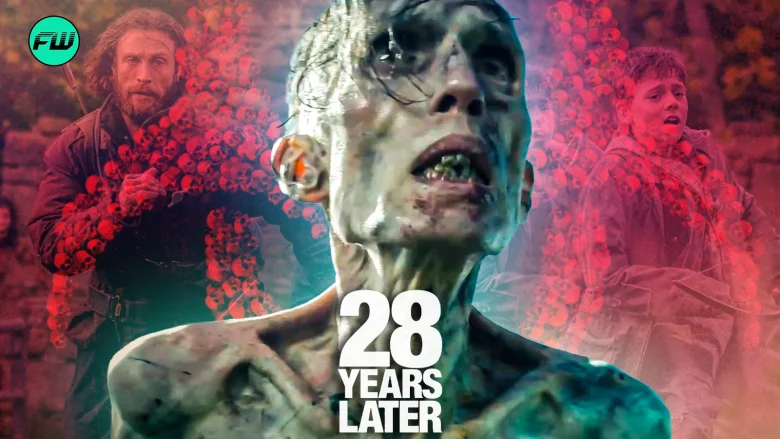28 YEARS LATER
Review by Eric Lindbom
-A dystopian diarrhea of epidemic Doomsday horror has not yet sent fans reaching for the Pepto-Bismol. They stay as hungry as George Romero’s army of desiccated, cannibal zombies who live on through ongoing reboots and variations worn out (the never-ending WALKING DEAD spin-offs) and emotive and fresh (HBO’s THE LAST OF US).
Now, director Danny Boyle and screenwriter Alex Garland are back together as foxhole buddies. Nearly a quarter of a century ago, they teamed to jazz up the genre with 28 DAYS LATER. That seismic work remains timely since its rage virus was unleashed in an animal lab mishap, not far removed from the wet market speculations around COVID. The horrific, ingenious 28 DAYS had a longer shelf life than its title indicated and is better remembered than its sequel, 28 WEEKS LATER, which neither worked on.

The new 28 YEARS LATER (in theaters) showcases both Boyle’s hot-blooded directorial flourishes and the same daring narrative choices Garland brought to his directorial genre works MEN and EX MACHINA.
Their rage virus is now confined to the UK, which is quarantined off by naval ships. A generation of survivors fend for themselves in the agrarian vs. urban setting of Lindisfarne, a bucolic island. Spike (Alfie Williams), a 12-year-old boy, worries about his mother Isla (Jamie Comer, the bright light of motorcycle flick THE BIKERIDERS), who is bedridden and mentally deteriorating. He faces a rite of passage as his pragmatic, imposing dad (Aaron Taylor-Johnson) accompanies him to the infected mainland so Spike, armed with a bow and arrow, can earn his first kill. They stave off an attack by the infected and return home as conquering heroes to raucous revelers at a bar. When Spike catches his tipsy dad in an adulterous embrace in an alleyway, the betrayed boy rouses his mom from her sick bed and takes her on a dangerous trek across the mainland in hopes that a rumored hermit doctor can cure her.
28 YEARS LATER justly enticed critics (and irritated some gorehounds) since neither peripatetic Boyle nor writer Garland stays in accepted horror lanes. The collaborators revel in tonal shifts throughout that are truly life-like, and not indebted to predictable scare movie tropes. There are long pastoral sequences, including undulating fields of grain gorgeously shot by cinematographer Anthony Dod Mantle. A walkway connecting the island to the mainland is buried underwater at high tide, creating both a ticking clock and an indelible image. The rusted-out mainland settings are eye-grabbers, including an abandoned Shell gas station (we know will explode) with its sign is altered to read “Hell.”
With his restless eye, Boyle eschews jump scares, but 28 YEARS is still plenty jumpy, the gore scenes splotchy, jolting, and fast. Boyle’s concussive editing may whiplash some viewers and the musical score by Young Fathers (three composers who worked on Boyle’s T2 TRAINSPOTTING) pounds like artillery — more Nine Inch Nails than Bernard Herrmann.
Boyle also inserts cheeky bits tying the survivors to the UK’s warring past. During scenes of the islanders teaching archery to kids, he inserts battle scenes from Laurence Olivier’s rousing Technicolor film HENRY V. These military motifs align 28 YEARS with Garland’s provocative CIVIL WAR, where moments of peace were also interrupted by bursts of lethal action. Garland also devises ingenious story elements including different strata of the infected from slow crawling, gluttonous beasties to an intelligent evolving strain. In a riveting scene in an abandoned train, an infected woman gives birth to a baby that may or may not carry the epidemic.
For all the bursts of blood, it’s not faint praise to note that some of 28 YEARS’ strongest moments are emotional, especially the encounter between Spike, ailing Isla, and Dr. Kenton, the mythic figure they’ve risked their lives to find. Ralph Fiennes, dyed red with iodine as insecticide to ward off the infected, has gone native but is a benevolent figure — a Colonel Kurtz in reverse. He’s erected a Watts Tower of skulls as a memento mori to commemorate all who’ve died on the mainland – including the infected. Garland’s dialogue here, delivered with Fiennes’s hushed gravitas, may bring some viewers to tears.
A gripping and surprisingly humanistic work, 28 YEARS LATER’s only minor misstep is a madcap epilogue regarding band of punk rock zombie hunters that’s a baldly Marvel-inspired tag to tease the next two chapters in a coming trilogy (all written by Garland). 28 YEARS LATER is such a lyrical experience, it’s easy to forget it’s product. Hence, such franchise marketing left an arid aftertaste that dissipated by the time I hit the lobby.
Eric Lindbom is a hardcore horror buff with a strong stomach, weaned on the Universal classics from the ’30s and ’40s. He’s written film and/or music reviews for City Pages, Twin Cities Reader, LA WEEKLY, Request magazine and Netflix. He co-edits triggerwarningshortfiction.com, a site specializing in horror, fantasy and crime short stories with illustrations by co-editor John Skewes. He lives in Los Angeles.







